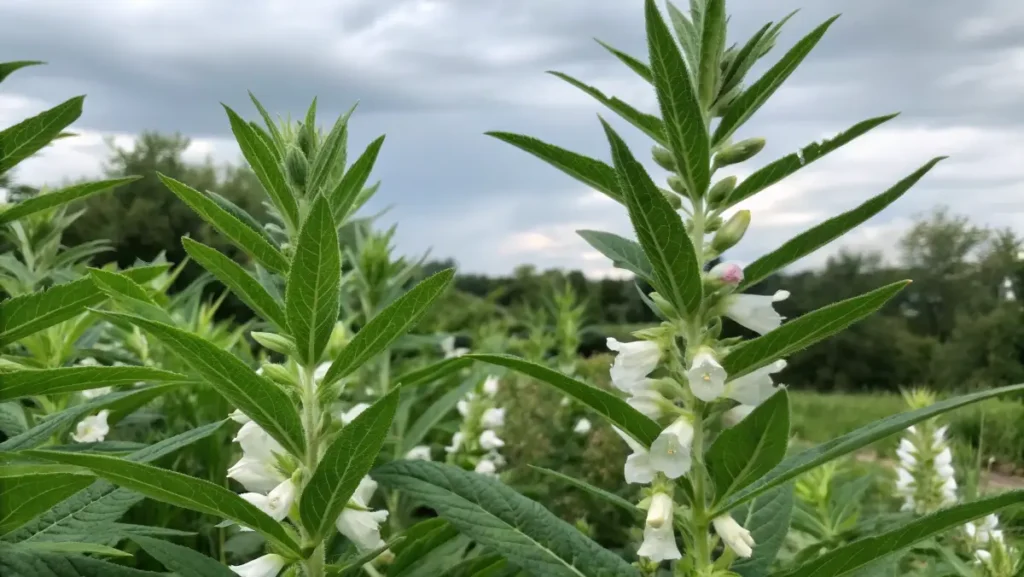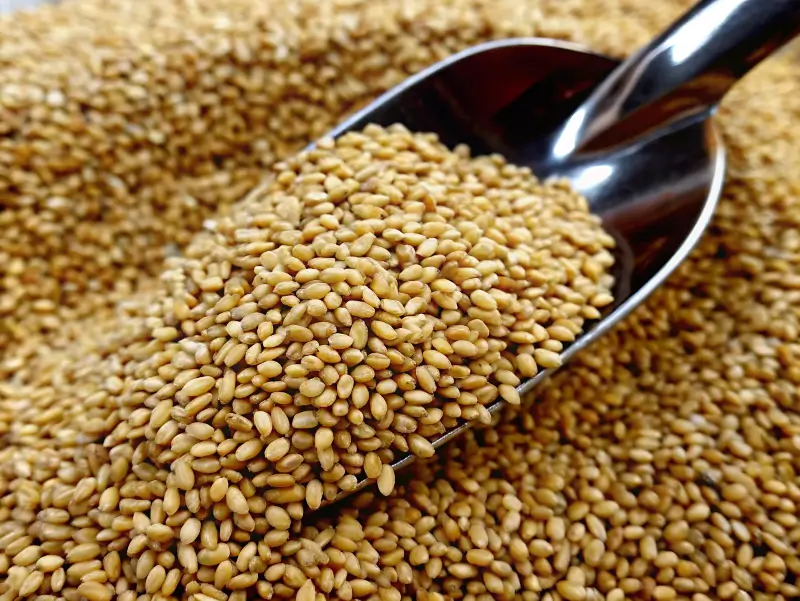
I’m so glad you’re here, and I promise this read will be worth your while! Today, we’ll look at the basics of planting, caring for, and enjoying the sesame plant. Honestly, I’ve always been curious: where do sesame seeds come from? In this article, I’ll chat about the sesame seed plant and why it’s such a garden favorite.
We’ll see how sesame plants grow, the popular varieties, and how they fit into a healthy lifestyle. Stick around for tips, personal insights, and answers to questions like what do sesame seeds grow into. Ready? Let’s jump right in!
Table of Contents
Introduction to the Sesame Plant
History and Basics
The sesame plant, known scientifically as Sesamum indicum, is believed to be one of the oldest oilseed crops out there. Ancient tales from Mesopotamia mention “Til” or “Benne seed,” revealing just how far back this plant’s story goes.
Short paragraphs make it easier for all of us to breathe, right? So here’s another quick snippet: people have long used sesame seeds for cooking, medicinal salves, and even religious observances. The seeds have a high oil content, making them perfect for toasted toppings, creamy sauces, and just about anything in between.
Where Do Sesame Seeds Come From?
Many folks ask, where do sesame seeds come from, imagining they pop out of nowhere. Actually, these tiny seeds develop inside pods that emerge on the tall stems of the sesame seed plant.
- Each pod contains several seeds, which eventually become that familiar sprinkle on burger buns.
- Pods open (sometimes with a little “pop”) when they’re ripe.
Those who want to begin growing sesame seeds will find it’s pretty approachable if you know a few basics. We’ll dive into that soon!
Anatomy and Growing Conditions of the Sesame Seed Plant
Seed Pods and Roots
The sesame plants generally stand a couple of feet high with sturdy green stems. Beneath the soil, they feature a deep-rooted system that helps them soak up water from lower layers of earth. Up top, you’ll notice tubular flowers that, in time, transform into oblong pods.
- These pods start out green.
- Then they turn brown as they mature, eventually splitting open to release seeds.
If you’re new to how to grow sesame plant, these visuals can help you monitor progress. Just keep an eye out for any changes in leaf color or pod shape.
Soil, Sun, and Water
The sesame seed plant thrives in:
- Full sun (at least six hours of direct light).
- Well-drained soil (so water never sits too long).
- Warm temperatures (they enjoy the 75–85°F range).
When growing sesame seeds, consistency is key. Though these plants are often called drought-resistant, they still need balanced watering, especially when young. Once the plant matures, its deep roots can handle limited rain better—handy for places with unpredictable weather. If you like houseplants too, you can pick up helpful drainage tips from Alocasia Frydek care guides.
Popular Varieties of Sesame

White Sesame vs. Black Sesame
Most of us have seen classic white seeds on bread, but black seeds offer a richer taste. Both come from the sesame seed plant yet can differ due to genetics.
- White seeds: Mild flavor, common in baked goods and Western dishes.
- Black seeds: Earthier taste, often spotted in Asian cuisines or gourmet toppings.
Local and Regional Strains
You’ve also got local strains adapted to specific climates. Some might be more pest-resistant, while others offer higher yields. When figuring out how to grow sesame plant for your region:
- Check with local garden suppliers for seed recommendations.
- Look at your state’s agricultural extension data for best planting times.
- Peek at USDA resources for official advice on soil pH and climate.
Culinary Uses and Nutritional Profile
Cooking with Sesame Seeds
If you haven’t smelled the aroma of toasted sesame seeds, you’re missing out. I toss a handful on my salads, stir-fries, and sushi rolls. There’s also pressed sesame oil, known for its strong, nutty scent.
- Sesame meal (the leftover after pressing oil) adds protein to baked goods.
- Lightly toasting seeds pumps up their flavor.
- Add them to roasted veggies or homemade bread dough.
The sesame seed plant is quite the gift for foodies who want versatile flavors without complicated steps.
Vitamins, Minerals, and Fats
These seeds are jam-packed with healthy fats, minerals, and even vitamin E. Thanks to a high oil content, they bring monounsaturated and polyunsaturated fats to your table. They also contain:
- Calcium, magnesium, and iron.
- B vitamins for energy.
- Zinc for immune support.
Because they’re a nutrition-rich superfood, it’s no wonder home cooks worldwide are adding them to daily meals.
Health Benefits and Medicinal Properties

Ancient and Contemporary Outlook
We’ve known for centuries that sesame seeds can be beneficial. Ancient Egyptians reportedly used them as a flour alternative. Modern uses often highlight:
- Traditional medicinal uses, like soothing skin irritations.
- Potential antioxidant properties.
- Support for balanced cholesterol, when part of a healthy diet.
My Personal Experience
Personally, I’ve noticed I feel more energized after enjoying sesame seeds at breakfast. Maybe it’s the blend of fats, protein, and minerals working together. While individual reactions vary, I like sharing this simple tip: keep a small bag of toasted seeds handy to sprinkle on oatmeal or yogurt. If you have any allergies or medical concerns, though, always check in with a licensed expert before making changes to your routine.
How to Grow Sesame Plant and Harvesting Tips
Getting Started with Growing Sesame Seeds
Curious how to grow sesame plant from scratch? Let’s do it step by step:
- Seed Selection: Look for high-quality seeds adapted to your climate.
- Planting Time: Wait until the soil warms up—usually late spring or early summer.
- Location: A sunny spot is best. Too much shade can stunt growth.
- Sowing Depth: About a quarter-inch deep is typical.
- Watering Routine: Keep soil evenly moist but not drenched.
In warm settings, seeds usually sprout in a week or two. Once seedlings appear, thin them out so each baby plant has enough elbow room.
Harvesting Cycle and Processing
Where do sesame seeds come from once you plant them? They grow in pods that turn brown as they mature. The pods crack open slightly, signaling harvest time.
- Carefully cut the stems and let them air-dry.
- Shake out the seeds onto a sheet or tray.
- Keep them in a cool, dry place for storage.
Because seed pods may mature at different times, you’ll likely do several mini-harvests, which is kind of fun. It’s like the sesame seeds plant version of a treasure hunt!
Common Pests and Diseases Affecting Sesame Plants
Identifying Threats Early
Just like any other crop, sesame plants can encounter pests or diseases. Aphids, whiteflies, or fungal issues can pop up. Keep an eye on:
- Foliage shifting to a yellow shade or curling around the edges.
- Strange spots on stems or leaves.
- Pods not forming properly.
If you notice small critters on the underside of leaves, try a gentle water spray or insecticidal soap. Using pest-resistant strains is also a good safeguard when growing sesame seeds in large fields.
Management Tactics
To keep problems at bay:
- Maintain a tidy garden by removing dead leaves.
- Change up your planting arrangement every growing season to interrupt pest life cycles.
- Use beneficial insects like ladybugs to control aphid populations.
- Watch the soil’s moisture level to prevent fungus.
A lot of folks say the best offense is a good defense: healthy plants tend to resist infestations better.
Environmental Impact and Sustainable Sesame Farming

Crop Rotation and Soil Fertility
Working the sesame seed plant into a rotation plan has proven incredibly helpful. Its long roots draw nutrients from deeper layers of soil, enriching the entire garden environment. This method:
- Helps maintain soil fertility management.
- Cuts back on excessive pesticide usage.
- Lowers the odds of repeating pest issues.
Eco-Conscious Practices
Because these plants are relatively drought-resistant, they don’t demand loads of irrigation. That’s a plus if you live somewhere with water restrictions. You can also toss compost or mulch around your sesame plants to reduce weeds naturally.
- Reduced chemical use: Less harm to pollinators.
- Healthier soil structure: Minimizes erosion.
- Cleaner streams: Fewer pollutants in runoff.
Small steps in your garden can have a ripple effect on the environment, especially if more folks adopt them.
Global Market and Economic Importance
Leading Producers of Sesame Seeds
If you’re still curious where do sesame seeds come from on a global scale, many hail from African countries like Sudan and Nigeria, as well as Asian nations like India and Myanmar. Lately, South American nations are also entering the market. In the United States, certain southern states have begun growing sesame seeds for local markets.
- Africa remains a major producer.
- India is a key player in export markets.
- U.S. growers are rising in popularity due to local demand.
Trending Tastes
Health-conscious shoppers are focusing on foods with simpler, natural ingredients, and that includes these nutty seeds. You’ll see them in:
- Baked goods (like muffins and breads).
- Snack bars or energy bites.
- Specialty seasonings (like gomasio).
This is fantastic news for small-scale growers or artisan producers who can share fresh seeds or homemade sesame oils with local consumers.
Frequently Asked Questions
Can Sesame Grow in the US?
Yes. The climate in many southern states is suitable for the sesame plant. With enough sun and moderate water, sesame plants can flourish. They’re typically an annual herbaceous plant, so you’ll replant them each year. Folks often start them in May or June once frost scares are gone.
Can I Grow Sesame at Home?
Sure thing. If you have a sunny patch, you can try growing sesame seeds right in your backyard. The key is warm soil and decent drainage. For folks with small spaces:
- Containers are an option if you use rich potting mix.
- Ensure the pots get direct sunlight for most of the day.
Is the Sesame Plant Edible?
We all know the seeds are edible, but the leaves can be eaten too in certain cuisines. However, most gardening enthusiasts focus on the seeds. The pods contain the prized seeds, and that’s what you’re chasing during harvest. So when someone wonders, what do sesame seeds grow into, the short answer is they grow into more seeds—and often some pretty flowers along the way!
Is a Sesame Plant a Perennial or Annual Plant?
A majority of the time, you’ll see the sesame plant grown as an annual, planted each year. If you live in a frost-free region, it might persist a bit longer. Typically, though, these plants complete their life cycle in one growing season. That means you plant, grow, harvest, and repeat next year if you want another supply of seeds.
Final Thoughts and Helpful Reminders
If you ask me, the sesame plant is just plain fun. By understanding what do sesame seeds grow into and how to grow sesame plant, you can enjoy a personal seed supply for cooking, baking, or gifting to friends. It’s pretty cool that you can open a pod and see all those seeds that once graced your bagel or noodle bowl.When you’re growing sesame seeds, keep these quick pointers in mind:
- Warm temperatures are essential.
- Avoid waterlogging the roots.
- Harvest pods when they turn brown.
- Store seeds in a dry space.
With a bit of care, you’ll have all the sesame seeds you need in no time. Have fun, and happy gardening!

3 thoughts on “Sesame Plant: Complete Guide for Growing and Using Seeds”
Comments are closed.